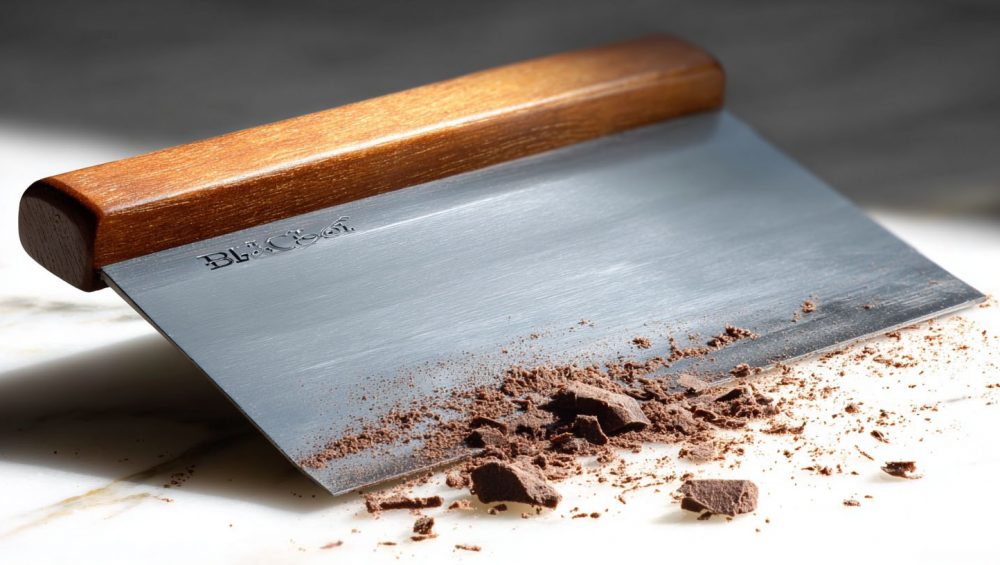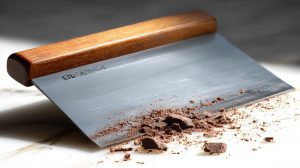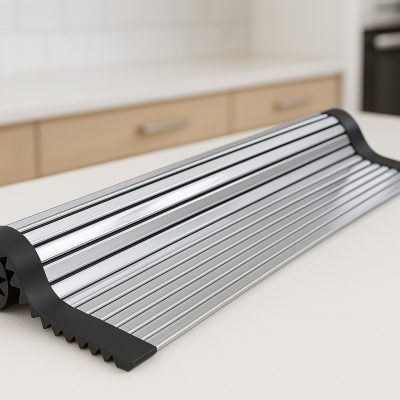Podcast:
Imagine the scene, a familiar moment of minor kitchen frustration: a pile of finely minced garlic, fragrant and ready for the pan, stubbornly clings to the cutting board. A swipe with the side of an expensive chef’s knife sends half the aromatic bits scattering across the counter and floor. Or consider the aspiring baker, whose beautiful, hydrated dough has transformed from a promising ball of potential into a sticky, unmanageable slick that seems permanently bonded to the work surface. These are the moments where kitchen joy can curdle into tedious cleanup. Yet, in professional kitchens and the homes of savvy cooks, a simple, elegant solution lies waiting, often hiding in plain sight: the bench scraper.
This unassuming rectangle of steel with a handle is, quite simply, the professional’s secret weapon. Described by those in the know as an “extension of your hand,” it embodies a rare combination of brute force and subtle finesse. Its profound versatility is hinted at by its many aliases. To a baker, it is a “dough scraper,” essential for dividing, portioning, and kneading. To a line cook, it might be a “chopper,” perfect for rough-cutting vegetables or smashing garlic. To television personality Rachael Ray, it is affectionately known as a “picker upper,” a name that perfectly captures its knack for shuttling ingredients from one place to another.
The tool’s provenance lies in the heart of the bakery, where it earned its name from the “bench”—the traditional worktable where bakers have mixed, kneaded, and shaped dough for centuries. This heritage gives it an unimpeachable professional pedigree. Yet, its journey from the pastry station to the savory side of the kitchen has not been without resistance. In a curious display of culinary gatekeeping, some professional chefs have historically dismissed the tool, labeling it as something “only for pastry chefs”. This sentiment reveals a deeper, unspoken cultural divide within some professional kitchens—a perceived hierarchy between the hot, fast-paced world of the savory line and the precise, methodical realm of pastry. In some toxic environments, the scraper has even been derided as a “women’s tool,” leading some cooks to absurdly use a burger flipper to make pasta just to avoid it. This context frames the bench scraper not merely as an unsung hero, but as one that has had to fight for its rightful, universal place. The home cook, blissfully free from this professional baggage, is uniquely positioned to ignore such arbitrary divisions and embrace the tool for what it is: a supremely functional, unbiased implement of culinary efficiency.
This report will move beyond the bench scraper’s well-documented role in baking. It will reveal five unexpected, game-changing applications that prove this humble tool is not just a gadget but a fundamental component of a well-run kitchen. From accelerating prep work and revolutionizing cleanup to executing tasks with artistic precision, the bench scraper is poised to earn its place not in the back of a drawer, but on the counter, right within arm’s reach, ready for anything.
The Prep-Work Accelerator: Your New Favorite Chopper

The first step in liberating the bench scraper from the confines of the bakery is to reconsider its edge. While not sharp in the traditional sense, its dull, straight blade offers a unique mechanical advantage, allowing it to excel at chopping tasks where a conventional knife can falter. This chapter repositions the scraper as a specialized chopping tool, perfect for soft, sticky, and otherwise awkward foods.
The Physics of the Perfect Cut: Blunt Force vs. Sharp Slice
A chef’s knife, with its fine, sharp, angled edge, is engineered to slice cleanly through fibrous materials like meat and firm vegetables. However, when faced with softer or stickier items, that same sharp edge can sometimes be a liability, dragging through the food, squishing it, or becoming hopelessly gummed up. The bench scraper operates on a different principle. Its unsharpened, beveled edge applies direct, uniform, vertical pressure across a wide surface area. It doesn’t so much slice as it does cleave, acting, as one baker described it, like a “little guillotine”. This method prevents sticking and ensures clean, neat divisions where a knife might create a mess.
This unique cutting action makes the bench scraper the ideal tool for a range of specific applications:
- Smashing and Rough Chopping: Many cooks are hesitant to use the broad side of an expensive Japanese knife to smash a clove of garlic, fearing damage to the blade. The bench scraper is the perfect, robust tool for the job. The flat of its blade can be used to decisively crush garlic cloves or fresh ginger, and its edge can follow up with a quick, rustic chop without risk.
- Conquering Sticky & Delicate Foods: The scraper’s non-stick tendency and guillotine-like action make it superior for portioning foods that cling tenaciously to a knife. This includes cutting bar cookies, brownies, fudge, or homemade granola bars directly in the pan, a task for which it is consistently recommended. For non-stick pans, a plastic or nylon scraper is advised to prevent scratching the surface. Its ability to slice cleanly through multi-layered tray bakes, such as oat crumble bars with a jam filling, without smearing or disturbing the distinct layers is a testament to its precision. It is also the perfect instrument for portioning logs of cold butter, soft and semi-soft cheeses, or even cutting delicate fresh pasta into ribbons.
- The In-Pan Pro Move: One of the most valuable, yet lesser-known, uses for a metal bench scraper is directly in a hot skillet. It is exceptionally effective for breaking up ground meat as it browns in a cast iron or stainless steel pan. Its wide, sturdy edge is more efficient than a wooden spoon for this task and safer for the pan’s surface than many metal spatulas.
An Agent of Culinary Confidence
The true impact of using a bench scraper for these tasks extends beyond mere efficiency. It acts as a powerful agent of culinary confidence for the home cook. The frustration of trying to cut a pan of brownies into neat squares, only to have them crumble and stick to the knife, can be a significant deterrent. It can make a recipe feel like a failure, discouraging future attempts.
The bench scraper, by its very design, removes this point of friction. It guarantees a cleaner, more satisfying, and more professional-looking result with minimal effort. This small success is empowering. A cook who can now produce perfectly uniform granola bars or flawlessly sliced lasagna is more likely to feel a sense of mastery. This confidence is cumulative; it encourages not only the repetition of that recipe but the willingness to tackle other, slightly more ambitious culinary projects. In this way, the bench scraper is more than just a chopper—it is a tool that lowers the barrier to entry for a wide array of recipes, fostering experimentation and tangible skill development.
The Master of Mise en Place: Your Ingredient Shuttle

Once ingredients are chopped, they must be moved. This transitional step, known as mise en place—the French term for having all your ingredients prepped and in place before cooking begins—is where the bench scraper truly shines, establishing itself as the ultimate conveyance from cutting board to pan.
The Inefficiency and Danger of the Alternatives
For most home cooks, transferring chopped ingredients is an afterthought, often accomplished with clumsy and inefficient methods. The most common approach is to use cupped hands, a technique that is not only messy but inevitably leads to dropped morsels of food on the counter and floor. The second method, far more common among those trying to emulate television chefs, is to use the side of the chef’s knife to scoop and carry ingredients. While this may look professional, it is flawed for several critical reasons.
The Scraper’s Tripartite Superiority
The bench scraper is a better tool for transferring ingredients for a trio of reasons: superior efficiency, the preservation of expensive tools, and enhanced kitchen safety.
- Capacity and Efficiency: The most obvious advantage is its size. The broad, flat surface of a standard 6-inch bench scraper has a significantly larger surface area than the blade of a chef’s knife. This allows it to scoop and transport an entire chopped onion, a large bunch of minced herbs, or a mound of chopped nuts in a single, swift, and secure motion. This efficiency translates to fewer trips between the cutting board and the stovetop, a cleaner workspace, and a more streamlined cooking process.
- The Knife Preservation Doctrine: This is perhaps the most crucial, high-value benefit for any cook who has invested in a quality chef’s knife. Repeatedly scraping the fine, sharpened edge of a knife across the abrasive surface of a cutting board causes microscopic damage and wear. Even using the spine of the knife is not ideal. This action, performed over and over, is a primary contributor to a dulling blade, reducing its cutting performance and requiring more frequent sharpening. The bench scraper, with its inherently dull and robust edge, is designed specifically for this kind of contact. It absorbs the abuse, thereby preserving the razor-sharp edge of the chef’s knife for the delicate slicing and dicing tasks it was designed to perform.
- Enhanced Safety: The simple act of moving chopped vegetables into a sizzling hot pan becomes markedly safer with a bench scraper. Using a wide, dull-edged tool to guide ingredients over the edge of the board eliminates the inherent risk of maneuvering a sharp knife blade near one’s fingers and hands. Professional chefs and culinary instructors alike advocate for this method as a fundamental practice of kitchen safety.
The stark contrast in performance between these tools for this specific, common task is best illustrated through a direct comparison.
Table 1: The Transfer Showdown: Bench Scraper vs. Chef’s Knife
|
Metric |
Bench Scraper |
Chef’s Knife (Blade or Spine) |
|
Efficiency (Capacity & Speed) |
High. Wide surface transfers large volumes in one go. Fewer trips. |
Low. Narrow surface requires multiple scoops or careful balancing. |
|
Safety (Risk of Injury) |
Very Low. Dull edge poses minimal risk of cutting hands. |
High. Scraping with a sharp blade near fingers is inherently risky. |
|
Tool Longevity (Blade Health) |
No Impact. Designed for scraping. |
High Negative Impact. Scraping dulls the knife’s edge over time. |
|
Cleanliness (Spillage) |
Minimal. Wide, flat surface contains ingredients effectively. |
Moderate to High. Ingredients easily fall off the narrow blade. |
By every key metric, the bench scraper is not just a valid alternative but the superior tool for the job. Adopting it for ingredient transfer is a simple change in habit that pays significant dividends in efficiency, safety, and the long-term health of one’s most essential kitchen knife.
The Cleanup Champion: Your Countertop’s Best Friend

Perhaps the most surprising and satisfying role the bench scraper can play is that of a cleanup champion. It excels at tackling the “un-wipeable” messes that plague every kitchen, from sticky dough residue to hardened, caked-on food. Its effectiveness lies in a simple, transformative principle: the “Scrape, Then Wipe” doctrine.
The “Scrape, Then Wipe” Doctrine
For many common kitchen messes, particularly in baking, a wet sponge or cloth is precisely the wrong first tool to grab. Applying moisture to loose, dry flour or sticky dough remnants instantly creates a gummy, glue-like paste. This paste smears across the countertop, clogs the sponge, and ultimately makes the cleaning process more difficult and frustrating.
The bench scraper provides the correct first step. Its rigid, straight edge is used to attack the physical mess before any liquid is introduced.
- Consolidate: The scraper is held at a roughly 45-degree angle to the surface and used to plow through the debris—be it scattered flour, bread crumbs, hardened chocolate, or sticky bits of dough.
- Collect: All the solid material is gathered into a single, neat pile.
- Remove: This consolidated pile can then be easily scooped up with the scraper and swept directly into a trash can or compost bin, often by holding the receptacle just below the edge of the counter.
Only after the vast majority of the solid mess has been physically removed is the surface ready for a final, easy wipe-down with a damp sponge or cloth. This two-step process is dramatically more efficient and less messy than attacking the problem with a sponge alone.
Expanding the Cleaning Domain
The scraper’s cleaning prowess is not limited to countertop flour. Its utility extends to a variety of challenging cleanup tasks throughout the kitchen and even beyond.
- On Bakeware and Cookware: It is the perfect tool for scraping burned or hardened drippings, such as caramelized sugar from an apple pie that has bubbled over, from a metal baking sheet. It can also be used to safely loosen stubborn, stuck-on food from durable cookware like cast iron skillets or carbon steel griddles before washing, reducing the need for harsh scrubbing.
- Truly Unexpected “Life Hack” Uses: The simple design of the bench scraper makes it a surprisingly effective multi-purpose tool for tasks that have nothing to do with cooking. Its dull-yet-effective edge can be used to:
- Remove stubborn stickers and price labels from new glassware or plastic containers.
- Chisel away spilled and hardened candle wax from tables or floors.
- Scrape frost or ice from a car window in a pinch.
- Disassemble a completed jigsaw puzzle, a favorite trick among enthusiasts who use the wide blade to scoop up and relocate large sections of the puzzle or gather all the pieces for storage.
A More Hygienic and Sustainable Approach
This “Scrape, Then Wipe” method offers benefits that go beyond simple effectiveness. It represents a more hygienic and sustainable approach to kitchen cleaning. Kitchen sponges are notorious breeding grounds for bacteria, a problem exacerbated when they become clogged with food particles. By using the bench scraper to remove the bulk of solid food waste first, the sponge remains significantly cleaner during the final wipe-down.
This has two positive effects. First, a cleaner sponge harbors less bacteria, contributing to a more hygienic kitchen environment. Second, because the sponge is not being subjected to the abrasive, clogging effects of heavy food debris, its functional lifespan is extended. This reduces the frequency with which sponges need to be sanitized or replaced, which in turn reduces waste. In an era of increasing focus on sustainable kitchen practices, adopting the bench scraper as a primary cleaning tool is a small but meaningful step toward reducing consumption and improving household hygiene.
The Precision Artist: Your Secret to Flawless Finishes

Beyond its workhorse roles in chopping and cleaning, the bench scraper possesses a more delicate, artistic side. It is an unassuming tool for achieving the kind of professional-level finesse that often seems out of reach for the home cook. With the correct technique, the scraper’s straight, rigid form becomes a guide, transforming wobbly, uneven attempts into sharp, flawless finishes.
Technique 1: The Impeccable Cake-Frosting Edge
While an offset spatula is the tool of choice for applying frosting, the bench scraper is the secret to creating perfectly smooth, flat, professional-looking sides on a layer cake. The technique is straightforward but transformative:
- After applying a generous crumb coat and final layer of frosting, place the cake on a turntable.
- Hold a metal bench scraper vertically, ensuring its bottom edge is flush with the turntable and its straight side is just touching the frosting. The scraper should be held squarely against the cake.
- With one hand holding the scraper steady, use the other hand to slowly and smoothly rotate the turntable. The scraper shears away the excess frosting, leaving behind a perfectly flat, vertical plane.
For an even more pristine finish, professionals employ the “hot scraper” hack to eliminate the tiny, frustrating air bubbles that can mar a buttercream surface. After the initial smoothing, the metal bench scraper is run under hot water and then quickly wiped dry. The residual heat on the blade is just enough to slightly melt the very outer layer of the buttercream as it passes over the surface. This subtle melting action fills in any remaining pinholes or imperfections, resulting in a glass-like, flawless finish.
Technique 2: The Perfect Cookie Log
For anyone who loves the convenience of slice-and-bake cookies, achieving a perfectly round, uniform log of dough can be a challenge. Baker Zoë Kanan has popularized a brilliant technique that uses the bench scraper to build tension and force the dough into a perfect cylinder.
- Place the log of cookie dough on a sheet of parchment paper.
- Fold the parchment paper over the log of dough.
- Place the straight edge of the bench scraper against the fold of the parchment, right at the base of the dough log.
- While holding the loose end of the parchment taut with one hand, use the other hand to push the bench scraper firmly against the base of the log. This action tucks the parchment tightly around the dough, building up tension and squeezing out any air pockets.
- Repeat this pushing and tightening motion a few times, rotating the log as you go. The result is a perfectly cylindrical, dense log of dough that will yield uniformly round cookies. This same technique can be applied to create elegant logs of compound butter or a perfectly shaped chocolate salami.
Technique 3: The Evenly Oiled Pan
A final, deceptively simple hack transforms the mundane task of greasing a pan into an act of precision. Instead of using fingers or a paper towel, which can result in an uneven coating, the bench scraper provides a superior method for oiling a sheet pan.
Simply pour a small amount of oil onto the baking sheet. Then, use the flat edge of the bench scraper to spread the oil across the entire surface. The scraper acts like a squeegee, distributing a perfectly even, thin film of oil that reaches into every corner and crevice of the pan. This is especially crucial for recipes like focaccia or pan pizza, where an even layer of oil is essential for a crisp, golden-brown crust and easy release.
The Democratization of “Technique”
These applications reveal a deeper truth about the bench scraper: it democratizes professional technique. Tasks like frosting a perfectly smooth cake, making uniformly shaped cookies, or achieving an evenly crisp crust are often perceived as requiring innate talent, a preternaturally steady hand, or years of dedicated practice.
The bench scraper, however, externalizes much of that “skill.” It acts as a physical guide—a reliable straight edge, a tension-building force, a flawless smoother. The process becomes less about the fallibility of the human hand and more about the reliable, repeatable application of a simple tool. By making these high-level results accessible to anyone, the bench scraper empowers the home cook. It bridges the gap between aspiration and achievement, transforming their perception of their own abilities and encouraging them to create food that is not only delicious but also beautiful.
The Minimalist’s Multi-Tool: The Gadget That Replaces Other Gadgets

In an age of kitchen clutter, where drawers overflow with single-use gadgets—the avocado slicers, the banana keepers, the strawberry hullers—the bench scraper stands in stark, elegant opposition. It is the antithesis of the “unitasker.” It is a champion of the minimalist kitchen philosophy, earning its small sliver of drawer space many times over by performing the jobs of three, four, or even five other tools.
The Multi-Tool in Action
The true value of a tool in a minimalist kitchen is measured by its versatility. The bench scraper is a paragon of multi-functionality, seamlessly stepping into roles typically assigned to a host of other utensils.
- It’s a Pastry Blender: For recipes like biscuits, scones, or pie crust, which require “cutting” cold fat into flour, the bench scraper is an ideal substitute for a dedicated pastry blender. Its stiff, straight edge can be used to chop cold butter, shortening, or lard into the dry ingredients, creating the small, flour-coated pieces of fat that are essential for a flaky texture.
- It’s a Pasta & Pizza Cutter: The beveled edge of a metal scraper is perfectly suited for cutting sheets of fresh pasta into noodles or portioning tender gnocchi pillows. It can also slice through a hot, thin-crust pizza with surprising ease, providing a clean cut without dragging the cheese and toppings the way a rolling pizza cutter sometimes can.
- It’s a Leveling Tool: Precision in baking often comes down to accurate measurements, and nothing is more crucial than correctly measured flour. The straight edge of the bench scraper is the perfect tool to sweep across the top of a measuring cup, leveling off the flour or sugar for a precise, consistent measurement every time.
- It’s an Impromptu Spatula: While not its primary function, the scraper’s thin, wide blade allows it to stand in for a spatula in a pinch. It can be used to carefully lift a delicate fish fillet from a pan, loosen cookies or pastries from a baking sheet, or transfer a fragile cake layer.
A Philosophical Choice for the Modern Kitchen
The decision to own and master a bench scraper is more than just a practical one; it is a philosophical choice that aligns with the principles of an intentional, minimalist approach to cooking. The modern marketplace bombards consumers with specialized gadgets, promising to solve one tiny problem at a time, leading to overstuffed drawers and a reliance on equipment over skill.
The bench scraper represents a conscious rejection of this trend. It is a tool that rewards understanding and technique. It is inexpensive, incredibly durable, and takes up almost no space, yet its utility is vast. By embracing this single, versatile tool, the home cook makes a statement. It is a commitment to valuing multi-purpose functionality, to building skill rather than accumulating gadgets, and to creating a more efficient, streamlined, and joyful kitchen environment. The bench scraper is not just another tool; it is an emblem of a smarter, more intentional way of cooking.
A Buyer’s Guide: Choosing Your Kitchen Sidekick

Convinced of its merits, the prospective buyer is faced with a surprising number of choices. Bench scrapers come in various materials, sizes, and designs, each with specific strengths and weaknesses. Understanding these differences is key to selecting the perfect tool—or set of tools—for one’s individual cooking style.
The primary considerations are the materials of the blade and handle, and the presence of features like ruler markings. A metal blade is the all-around workhorse, while a flexible plastic scraper serves as an invaluable specialist. Pastry chef Ashley Summers advises looking for a rounded plastic handle for comfort and ease of cleaning, while noting that porous wooden handles can hold bacteria and require more care. For those who bake frequently, etched measurement markings are a non-negotiable feature for ensuring uniformity in rolls and pastries.
The following matrix breaks down the anatomy of a bench scraper to guide the purchasing decision.
Table 2: The Anatomy of a Bench Scraper: A Buyer’s Matrix
|
Component |
Option |
Pros |
Cons |
Best For… |
|
Blade Material |
Stainless Steel (Rigid) |
Durable, holds a beveled edge for cutting, highly effective for scraping. |
Can scratch delicate surfaces like non-stick pans or silicone mats. |
All-purpose use, dividing dough, chopping vegetables, cleaning countertops, breaking up ground meat in a pan. |
|
|
Plastic (Flexible/Stiff) |
Safe for non-stick pans & silicone mats; flexible versions are excellent for scraping bowls. |
Less effective for tough scraping jobs; can break or lose its edge over time. |
Scraping batter from bowls, cutting brownies in a non-stick pan, working on a Silpat mat. |
|
Handle Material |
Plastic/Rubber |
Comfortable, non-slip grip, easy to clean, often dishwasher-safe. |
Can become sticky or show wear over time; less durable than steel. |
All-around home use, especially for cooks who value comfort and will be handling wet or oily ingredients. |
|
|
Wood |
Aesthetically pleasing, classic look, comfortable feel. |
Porous (can harbor bacteria), requires hand-washing and periodic oiling to prevent splitting. |
Cooks who prioritize aesthetics, are willing to hand-wash their tools, and appreciate a traditional feel. |
|
|
Molded Steel |
Extremely durable, seamless and hygienic, very easy to clean. |
Can be slippery when wet or oily, can feel cold to the touch. |
Professional environments or home cooks who prioritize maximum durability and sanitation over grip comfort. |
|
Key Feature |
Ruler Markings |
Allows for precise portioning of dough, checking pastry thickness, and cutting uniform items. |
Can be visually distracting for some users; not essential for non-baking tasks. |
Bakers making uniform rolls, pasta, or pastries; anyone who values precision in portioning. |
Ultimately, many serious cooks and bakers, including the testers at publications like Food & Wine and Serious Eats, conclude that the ideal solution is to own a set, such as the popular Chef’n Pastrio, which includes a metal scraper, a stiff plastic scraper, and a flexible bowl scraper. This trio, often nesting together for compact storage, equips a kitchen to handle any task with the perfect tool for the job.
Conclusion: An Extension of Your Hand, A Hero for Your Home

The journey of the bench scraper—from the flour-dusted benches of professional bakeries to the multifaceted demands of the modern home kitchen—is a story of quiet, unassuming competence. It begins as a simple dough cutter but reveals itself to be a specialized chopper for challenging ingredients, a master of mise en place that protects our most valuable knives, a cleanup champion that conquers messes sponges cannot, a precision artist for flawless finishes, and a minimalist’s multi-tool that declutters our drawers and our minds.
Its value is championed by the culinary world’s most respected voices. It is a core part of the curriculum at culinary schools like The Chopping Block, where it is celebrated as an essential tool that makes kitchen tasks easier and safer. It is a fixture in the kitchens of America’s Test Kitchen, where it is used for far more than just pastry. And it is the one tool that a culinary icon like Alton Brown declares he “can’t imagine cooking without,” a testament to its profound and versatile utility.
For a modest investment, this simple, elegant tool offers a disproportionately large return in efficiency, safety, and culinary creativity. It empowers the home cook to work cleaner, faster, and with greater confidence. It is more than a utensil; when wielded with understanding, it becomes what so many chefs have called it: a true extension of the hand. It is time to rescue this unsung hero from the depths of the gadget drawer, give it a place of honor on the countertop, and unlock a new level of joy and mastery in the heart of the home.







